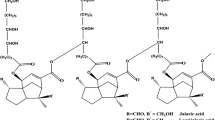Abstract
Coat material fromBacillus stearothermophilus spores has been examined for the following properties: X-ray diffraction pattern, infrared absorption spectrum, mechanical strength, and melting temperatures of the crystalline regions. The X-ray diffraction pattern of the coat material is different from that of both α-and β-keratin. The high melting temperature of the crystalline material indicates that its bonding is more stable than that of α- or β-keratin. The mechanical strength of the coat material ≃109N/m2 is shown to be high enough to allow the coat to support the internal pressure in bacterial spores. This pressure has been postulated to produce a partial dehydration, which increases the ability of bacterial spores to withstand high temperatures in water.
Similar content being viewed by others
Literature Cited
Algie, J. E. 1980. The heat resistance of bacterial spores due to their partial dehydration by reverse osmosis. Current Microbiology3:287–290.
Aronson, A. J., Fitz-James, P. 1976. Structure and morphogenesis of the bacterial spore coat. Bacteriological Reviews40:360–402.
Bendit, E. G. 1966. Melting of α-keratin in vacuo. Textile Research Journal36:580–581.
Bendit, E. G. 1966. Infrared absorption spectrum of keratin. I. Spectra of α-, β-, and supercontracted keratin. Biopolymers4:539–559.
Bendit, E. G. 1966. Infrared absorption spectrum of keratin. II. Deuteration studies. Biopolymers4:561–577.
Bendit, E. G., Feughelman, M. 1968. Keratin, pp. 1–44. In: Encyclopedia of polymer science and technology, vol. 8. New York: John Wiley and Sons.
Bendit, E. G., Kelly, M. 1978. Properties of the matrix in keratins. Part I. The compression testing technique. Textile Research Journal48:674–679.
Ebersold, H. R., Lüthy, P., Cordier, J. L., Müler, M. 1982. A freeze substitution and freeze fracture study of bacterial spore structures. Journal of Ultrastructure Research76:71–81.
Kadota, H., Ijima, K., Uchida, A. 1965. Presence of keratin like substances in spore coat ofBacillus subtilis. Agricultural and Biological Chemistry29:870–875.
Perry, R. H., Chilton, C. H., eds. 1973. Chemical engineers handbook, 5th Edn., pp. 6–93. New York: McGraw-Hill.
Warth, A. D., Ohye, D. F., Murrell, W. G. 1963. Location and composition of spore mucopeptide inBacillus species. Journal of Cellular Biology16:593–609.
Author information
Authors and Affiliations
Rights and permissions
About this article
Cite this article
Algie, J.E., Lindsay, J.A. Some physical properties of coat material fromBacillus stearothermophilus spores. Current Microbiology 9, 121–125 (1983). https://doi.org/10.1007/BF01567283
Issue Date:
DOI: https://doi.org/10.1007/BF01567283



